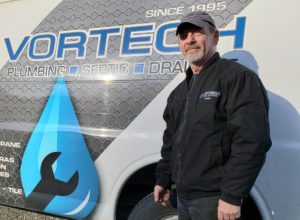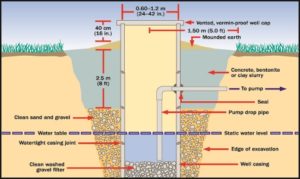Small-Diameter Wells
Drilled Wells
A drilled well consists of a small-diameter casing ranging in size from 10-20 cm (4-8 in.). Drilled wells obtain water from either overburden or bedrock aquifers. Overburden wells include those constructed into overburden aquifers (the geological materials above bedrock), composed typically of sands and gravels, but also possibly of silts and clays.
Most water wells are constructed with a well screen that allows groundwater to enter a well while keeping sand and other materials out. A properly constructed overburden well is shown in Figure 2. Well screen openings are sized carefully to allow sediment-free water to flow efficiently into the well and improve the connection between the well and the aquifer. Wells are “developed” during construction by the contractor to ensure that pumped water is sediment-free. The contractor will pump the well for an extended period and agitate water (also called surging) in the well, to remove fine-grained sediments from the area of the aquifer close to the screen.
An unscreened, poorly screened or poorly d developed well is usually less efficient to operate and more difficult to maintain than a properly constructed (screened) well, because sediment can enter the well and plug it. A plugged well will require more frequent well maintenance or replacement, have a reduced pump life because of greater use and abrasion of parts, and will generally have increased pumping costs.
Diagram showing subsurface view of drilled over-burden well into a sand or gravel aquifer. The well has a foot valve topped with a packer seal, the static water level rises to a watertight casing surrounded by an annular seal made of cement grout, concrete, bentonite or clay slurry.

Figure 2. Best management practices for a properly constructed, drilled overburden well
Bedrock wells are drilled down through the overburden (e.g., soils and sediments) and into the bedrock. The portion of the casing that extends from the ground surface to the top of the bedrock is often cemented around the exterior at the bedrock to ensure a good seal and avoid leakage of water from the overburden into the well. A well screen is usually not used where bedrock is stable but may be installed to stabilize the drill hole if the rock is highly fractured or unstable and likely to cave in. Drilled bedrock wells, like drilled overburden wells, are developed during construction to ensure sediment-free water.
A properly constructed and maintained drilled well should prevent the entry of any foreign substance into the well casing that might impair water quality. When a well is drilled, a bore hole is created into which the well casing is placed. The annular space, which is the space between the casing and the outside of the borehole, should be sealed with a suitable sealant (e.g., bentonite slurry, cement grout or concrete). The casing should be watertight, made from approved materials, and the joints should be welded or properly sealed. This watertight method of construction (using the best management practices shown in Figure 2) makes drilled wells less vulnerable to contamination than other types of wells.
Existing drilled wells that do not meet the specifications in Figure 2 can be upgraded in a number of ways:
- Extend the well casing above finished ground surface by at least 40 cm (16 in.). Where a drilled well is located in a well pit, remove the well pit casing (e.g., concrete tile), extend the casing above the ground surface, backfill and seal.
- Mound soil around the well casing above normal ground level and slope it away from the casing to direct surface water away from the well.
- Cover the top of the casing with a commercially manufactured, vermin-proof well cap.
A complete well maintenance checklist including these and other best management practices is provided on page 66 of Best Management Practices, Water Wells, which is available individually or as part of Keeping Your Well Water Safe to Drink: An Information Kit to Help You Care for Your Well. These best management practices either meet or exceed the requirements of the Wells Regulation.
Diagram showing subsurface view of a sand-point well jetted or driven into a shallow sand or gravel aquifer. Water is drawn by a pump through a well screen into a riser pipe, and then through a buried pipe to the point of use.





